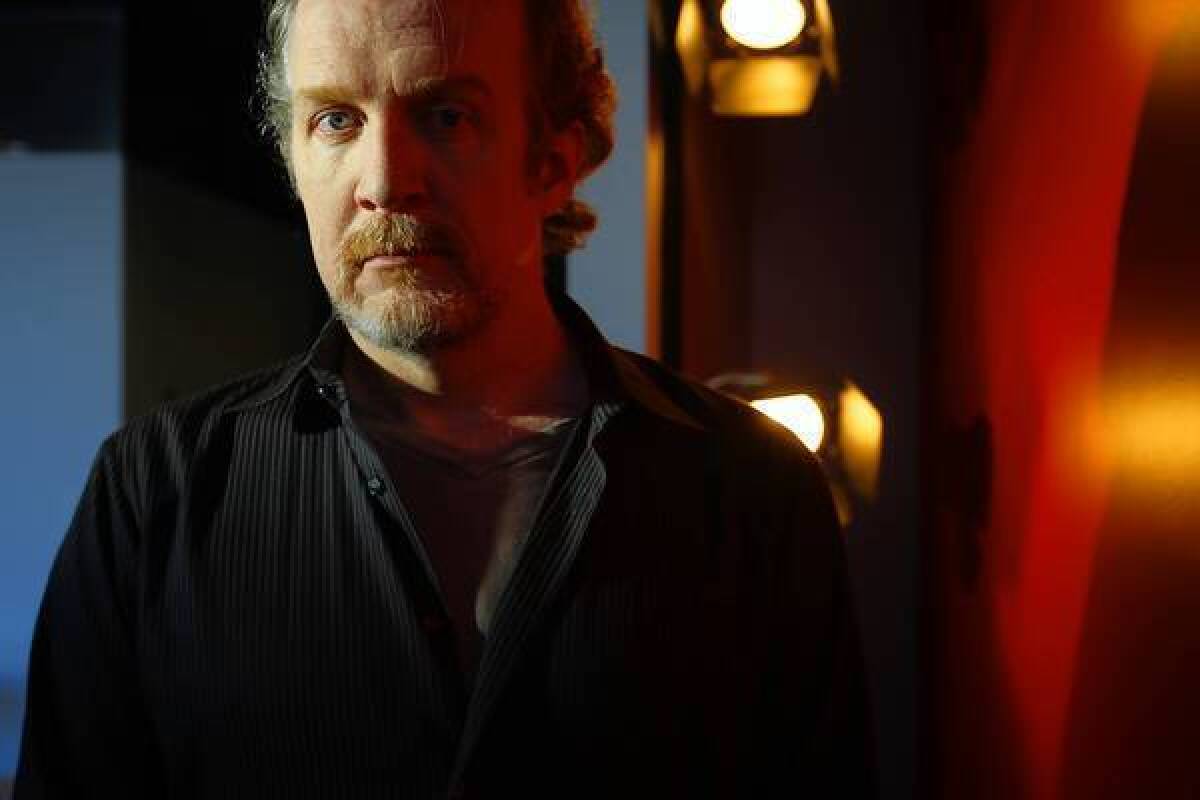Tracy Letts finally makes it to Broadway stage

- Share via
NEW YORK — A few years ago, Tracy Letts was at the Broadway rehearsal of a play he’d written when he noticed some of the younger actors slacking off. Letts pulled them aside.
“Don’t take this for granted,” the playwright and actor told them. “I mean, I’ve never been on a Broadway stage.”
Letts recalled the story from a lounge area in the basement of the Booth Theater, where about an hour later, he had stepped onstage as George, that embodiment of human complexity and marital dysfunction in the revival of Edward Albee’s classic “Who’s Afraid of Virginia Woolf?” The celebrated playwright and sometime actor can now count Broadway among his achievements.
PHOTOS: Arts and culture pictures by the Times
If at age 47, Letts has waited longer than most to take his place on the Great White Way, he has made up for lost time. For the last month, he has been delighting audiences with his verbal and physical gymnastics, unleashing quips and rants on wife Martha (Amy Morton), always moving as he sprawls across the floor, towers over perceived antagonists and curls himself up in self-protective balls, both eviscerator and eviscerated.
Albee’s 1962 play follows the story of a soused couple and the invective (and revelations) they toss at each other like horseshoes. A younger couple is there too, as spectators at first and eventually as participants. Unlike Mike Nichols’ 1966 movie, in which Elizabeth Taylor and Richard Burton enact the story with a dreary depressiveness, there is a wit here, even in the darkest moments.
And though the setting is a mid-20th century college town and Martha seems etched in a pre-feminist era, the play feels strikingly up-to-date, full of quotable smack-talk and modern themes.
“The underlying universality of the thing is that it’s about the illusions we create in order to get by,” Letts said.
Critics have certainly found Letts’ arrival as an actor on Broadway welcome. The New York Times called his performance “electrifying”; Linda Winer wrote in Newsday that Letts pulled off “an astonishing, star-making portrayal of a dynamic, comfy-in-his skin George.”
PHOTOS: Arts and culture pictures by the Times
Letts admits he reads every review, but he can’t resist a shot at critics.
“Sometimes when you get a bad review, the reviewer feels like he wants to suggest how this could be better,” he said. “And my reaction always is: ‘Don’t they think we thought about this? Like, a hundred times?’”
After nearly two months, he also says the show has taken a toll on his body, especially when he has to be onstage for more than six hours, as he does on Saturdays, when there are two performances.
The New York setting hasn’t helped. Letts talks about being a Chicagoan thrown into the pace of the city — and that was before Superstorm Sandy hit. He’s been living Uptown and didn’t lose power (the show was dark for only a day or two) but still had to negotiate a reeling metropolis and a shell-shocked audience.
It’s a trade-off, however, that Letts will gladly make. After his revenge-drama “Killer Joe” premiered in a cramped Chicago theater in 1993, he struggled for years writing edgy work, which also included the conspiracy-themed “Bug.”
That changed in the summer of 2007, when his “August: Osage County,” a story of family dysfunction he set in his home state of Oklahoma, opened at Steppenwolf and dazzled both local and New York critics. The show soon moved to Broadway, where it became the rare drama that was also a commercial smash. Letts went on to win both a Pulitzer Prize and a Tony Award for “August” in 2008.
Hollywood has also come calling in recent years. “Killer Joe” and “Bug” have both been turned into William Friedkin movies, while a film version of “August” produced by George Clooney and starring Meryl Streep and Julia Roberts has just finished shooting in Oklahoma. Letts wrote the screenplays for all three films, even visiting the “August” set several months ago to entertain questions from Roberts and Streep.
Even as his writing career skyrocketed, he continued a prolific acting career at Steppenwolf. He acknowledges, with a characteristic hint of sarcasm, that playing a role on Broadway is different.
“It does have a certain meaning,” he said. “But I can’t tell you what that meaning is.”
He deals with this as he has other challenges — with a spiky persona that George might admire.
“There’s something delightfully curmudgeonly about Tracy,” said his longtime friend Pam McKinnon, who directs Letts in “Woolf. “He’s a strange combination of frowning yet warm.”
Letts, who was carrying a book by John le Carré, said he had a fondness for spy novels and a skepticism about a certain type of literary fiction.
Rolling his eyes, he said, “Every time I try to read one of those books I think, ‘Yeah, I know someone who lives in Brooklyn wrote this and thinks it’s great, but nothing really happens, so why am I reading this?’”
But ultimately, he says, it’s a routine that’s kept him grounded during a rollercoaster few years.
“After the success of ‘August,’ there were people saying I should change my life. And maybe I should have bought a yacht and traveled the world instead of returning to Steppenwolf to act in and write plays,” he said. “But I’m from the Midwest, and that’s what we do: We go back to work.”
MORE
INTERACTIVE: Christopher Hawthorne’s On the Boulevards
TIMELINE: John Cage’s Los Angeles
PHOTOS: Arts and culture in pictures
More to Read
The biggest entertainment stories
Get our big stories about Hollywood, film, television, music, arts, culture and more right in your inbox as soon as they publish.
You may occasionally receive promotional content from the Los Angeles Times.











